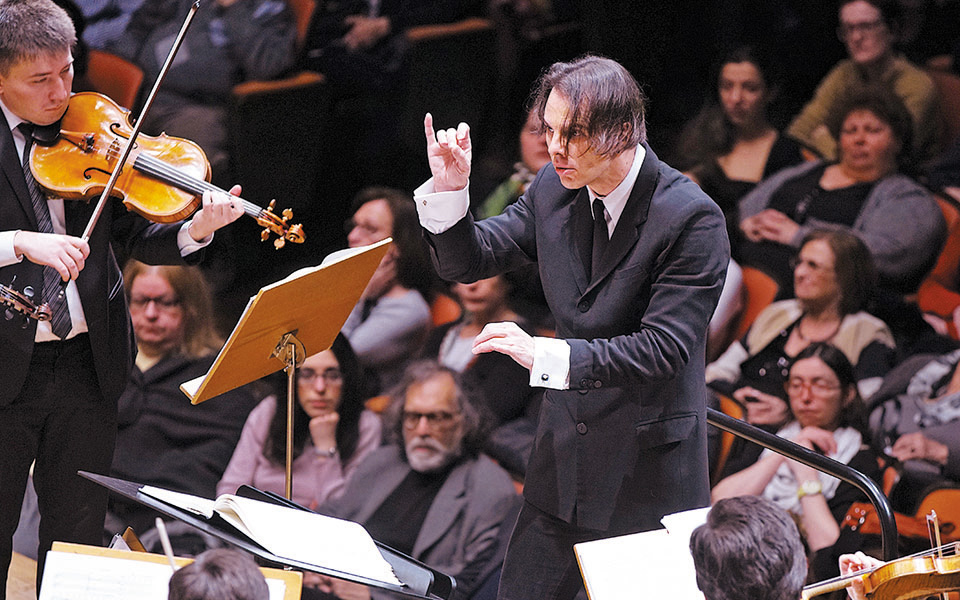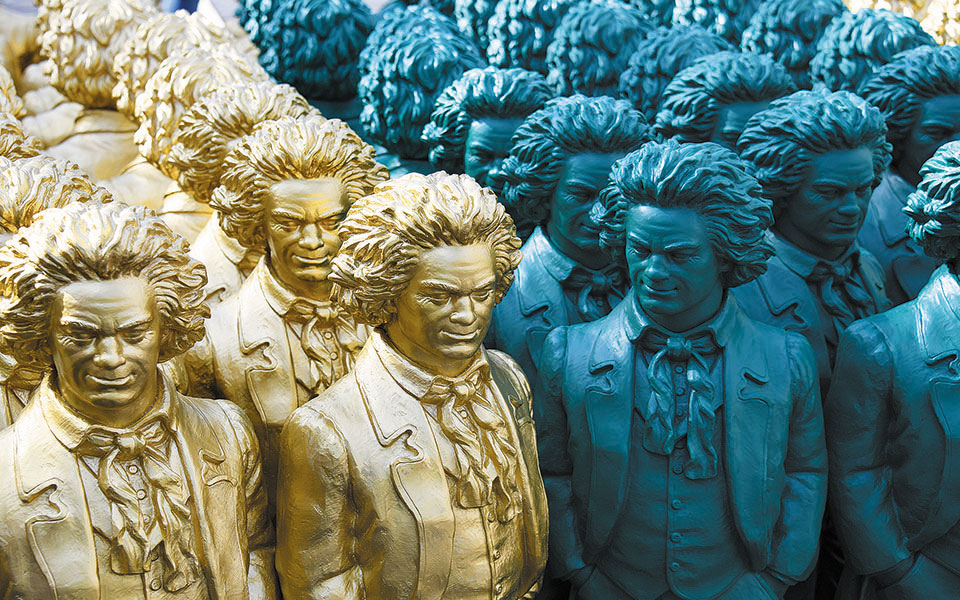by Ilias Maglinis
In early February 1819, the always restless (and well-read) Beethoven notes in his diary: “The Moral Law within us and the starry Sky above us”… Kant!” As Lewis Lockwood, a Harvard musicologist and Beethoven’s biographer (Beethoven’s Empire of the Mind, 2020), writes in The New York Review of Books, the three exclamation marks are Beethoven’s, followed by the name “Litrow,” who was director of an observatory. “It’s been known for a long time,” Lockwood writes, “that a few days before this diary entry, Beethoven had seen an article signed by astronomer Joseph Litrow, which ended with an excerpt from Kant’s “Criticism of the Practical Speech.” In other words, Beethoven copies the words of astronomer Litrow, who in turn copied Kant.
“For Beethoven,” Lockwood continues, “this is not just a passing thought but a moment of reflection on a key issue as to how he saw the world. Although Beethoven in this diary entry quotes the words of Litrow, not Kant, it is impressive that in the Kantian original we find a brilliant description of the feelings that one is overwhelmed by when he looks at the sky and reflects about his place in the universe.”
The great musician would have been deeply moved on Sunday, June 6, when Theodoros Kourentzis conducted the MusicAeterna orchestra in Symphony No. 7 in Α major, project 92 at the Ancient Theatre of Delphi. The concert took place as part of the pan-European celebrations for Ludwig van Beethoven (1770-1827 – last year was the 250-year anniversary of his birth).
In addition, the concert, organized by the Franco-German television station ALTE, in collaboration with German state television (ZDF), and with the participation of Megaron- the Athens Concert Hall, was attended by the dancer Sasha Waltz in a choreography designed specifically for the evening.
The concert was of special importance: part of a musical relay with interpretations and transmissions of all nine Beethoven symphonies at pan-European level.
At 2 p.m. it began in Bonn, Beethoven’s birthplace, the concert of symphony No. 1, the baton was then taken by Dublin with Symphony No.2, in order to continue: Helsinki (Symphony No. 3, Heroic), Luxembourg (Symphony No. 4), Prague (Symphony No. 5), Lugano (Symphony No. 6, Pastoral), Delphi with Symphony No 7, Strasbourg (Symphony No. 8) reaching Vienna (where Beethoven died) with Symphony No. 9, at 10 p.m., Greek time.
Megaron-Athens Concert Hall screened all the concerts from two giant screens in its garden live for free (with a limited number of spectators following the applicable health guidelines).

© ANA-Athens-Macedonian News Agency / MEGARON-ATHENS CONCERT HALL / CHARIS AKRIVIADIS
It was easy to see the gravity of the interpretation of The 7th Symphony in Delphi by Theodoros Kourentzis. The universal dimension and metaphysical dynamics of the ancient oracle suits the great composer. We imagine the most orgiastic, Dionysian, dancing of all the Symphonies, Beethoven’s 7th, in this unique setting.
This great work was completed in 1812, when Beethoven was 41 years old and the most famous composer throughout Europe. However, apart from living in turbulent times, he was, as usual, in personal, emotional turmoil, for a variety of reasons. As he wrote to a friend in February 1812, “Heavens, help me bear it all: I am not Hercules who helped Atlas carry the world on his back, let alone carry him on his behalf,” concluding, with another reference to ancient Greek mythology, that “Daedalus faced the labyrinth with the invention of the wings that raised him high, in the air. Oh, and I will find those wings.”
To the extent that the work reflects the artist’s emotional state and experiences, Beethoven seems to have found (at least temporarily) the “wings of Daedalus” in the composition of the 7th Symphony, as three of its four parts seem to express this apotheosis of the rush of life.
But what about the part of the symphony that’s left? This is, in order, the second, slow, part of it, the most dramatic, and perhaps the most famous, Allegretto in the history of music (after the Allegro con brio, the notorious first part of the 5th one). Already since the premiere of the play, in December 1813, it has”haunted” the audience of the time, “even those who have no musical education,” as a music critic wrote in 1817 (Lewis Lockwood, Beethoven’s Symphonies: An Artistic Vision, 2015).
One can reasonably imagine that listening to this part at night in Delphi, with the stars shining on the firmament, can send us back into that “Kantian” entry in Beethoven’s diary in 1819, “The Moral Law within us and the starry Sky above us.”
Lockwood also mentions a related reference by Carl Cherney, which we find in the box set booklet of Beethoven’s string quartets by the Guarneri Quartet (Brilliant Classics), where David Moncour writes that, according to Cherney, the wonderful second – slow – part of the Quartet for strings in Ε minor number. 2 Work 59 (the second of the so-called “Quartetta Razumovski”), was inspired by Beethoven while observing the starry sky, pondering “the music of the spheres.”

© Shutterstock
The “first sight of an innumerable multitude of worlds”
But what does Kant write in “Criticism of the Practical Speech” and how do these words come back to Beethoven’s music?
In the selections of this fundamental philosophical text, the German philosopher begins with a monumental sentence: “Two things fill the soul with always new and growing respect and admiration, the more often and more firmly the reflection deals with them: the starry sky above me and the moral law within me. I don’t have to look for them both and just assume them out of my sight, as if they were hidden in the dark or beyond; I see them in front of me and connect them immediately to the consciousness of my being. The first begins from the position I occupy in the outside world and broadens the connection I find myself in towards the infinitely large, with worlds beyond worlds and systems of systems, and moreover even in the vast times of their periodic movement, principle and duration.”
Comparing, in a sense, these two, Kant talks, among other things, about the starry sky as the “first sight of an innumerable multitude of worlds” which “somehow annihilates my importance as an animal creature that must return the matter from which it was made, to the planet (a simple spot in the universe), having been equipped for a short time with the power of life (we do not know how). On the contrary, the second (the moral law) infinitely elevates my value as an intellect through my personality, in which the moral law reveals to me a life independent of animal nature but even from the whole perceptible world.”
Kant suggests that he stands speechless in the face of night’s starry phantasmagoria: “The observation of the world began with the brightest spectacle that human senses can ever present to us and our minds ever watch and process to their wide extent, and ended up – in astrology” (let’s not get confused here and avoid any misunderstanding: Kant writes at a time when astrology did not have the meaning it has today but was used to describe astronomy).
The sounds of the 7th Symphony at the ancient oracle of Delphi came to unite Kant and Beethoven under the starry sky, which was not much different from that distant time when Pythia fell into ecstasy and talked about the future through riddles.
The music of the spheres
This composition, like most slow parts of Beethoven’s shocking string quartets, really has this Beethovenic balance between an incurable sadness of a deeply lonely night and the dynamics of a dormant volcano that at some point simply erupts.
Lockwood, however, distinguishes other moments by Beethoven, where this concept (or even sense) of the “music of the upper spheres” is intense, pervasive, riveting: in credo (I believe) of the religious Missa Solemnis and in the famous last, choral, part of the 9th Symphony based on Frederick Schiller’s “Ode to Joy.” Especially when it comes to the latter, Lockwood also focuses on Schiller’s lyrics: “Do you sense the Creator, oh world? Look for Him beyond the stars!” In these Lockwood references, we would still dare to add the Egmond Introduction, the unthinkable slow part (Adagio sostenuto) of the Hamerklavier sonata, as well as the demonic, agonizing third part (Allegro ma non troppo – Presto) of Apasionata.












